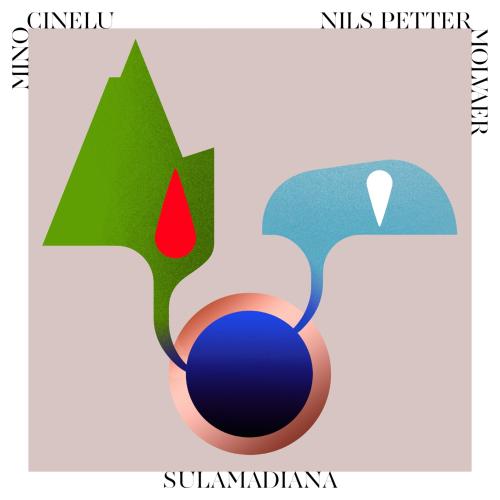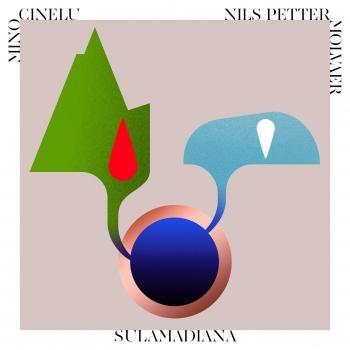
SulaMadiana Mino Cinelu & Nils Petter Molvær
Album info
Album-Release:
2020
HRA-Release:
04.09.2020
Album including Album cover
I`m sorry!
Dear HIGHRESAUDIO Visitor,
due to territorial constraints and also different releases dates in each country you currently can`t purchase this album. We are updating our release dates twice a week. So, please feel free to check from time-to-time, if the album is available for your country.
We suggest, that you bookmark the album and use our Short List function.
Thank you for your understanding and patience.
Yours sincerely, HIGHRESAUDIO
- 1 Le monde qui change 00:59
- 2 New York Stroll 06:27
- 3 SulaMadiana (For Manu Dibango) 04:17
- 4 O Xingu 02:28
- 5 Take the A# Train 05:26
- 6 Theories of Dreaming 01:54
- 7 Indianala 05:30
- 8 Kanno Mwen 03:34
- 9 Tambou Madiana (For Jimmy Cobb) 00:20
- 10 Process of Breathing 02:03
- 11 Rose of Jericho 06:35
- 12 Song for Julle (For Tony Allen) 03:38
- 13 Song for Julle (Oslo) 03:14
- 14 SulaMadiana, Pt. 1 03:39
Info for SulaMadiana
How do you create an entire world from nothing but tones, sounds and rhythms? A world full of width and depth, full of colors, movements and manifestations, with different temperatures and divergent courses of time. On “SulaMadiana”, it only takes two musicians to form such a world.
The album title is not some ancient spell, but a confession to the musicians’ respective biographies. Sula is the island from which Molvær stems, Madiana is a synonym for Martinique, where Cinelu’s father comes from.
The Norwegian trumpeter and the French percussionist represent two worlds, which – at first glance – could hardly be more different. Both are masters in the visualization of sound, and in changing the visible into the audible. Their musical home is the entire planet, but while Molvær's hoarse and cloudy trumpet sound evokes boreal cold, Cinelu stands for the rhythmic fire of Latin America and Africa.
On “SulaMadiana”, they finally found their common playground.“SulaMadiana” is a cornucopia, spilling out reverberations of Miles Davis, Gong, and previous works of Molvær, and yet Molvær and Cinelu open up doors to entirely new worlds.
“SulaMadiana” is a cornucopia, spilling out reverberations of Miles Davis, Gong, and previous works of Molvær, and yet Molvær and Cinelu open up doors to entirely new worlds.
The trumpet player did not pay much attention to this fact, but he was surprised to find Cinelu still at the same place even after the concert was over. They started talking, and when they drove to the airport the next morning, they came up with a plan for a joint project. It took two more years for them to meet again, at Ibrahim Maalouf’s all star concert in Paris, where they finally sealed the deal. Other projects in Germany and Poland followed, and the urge for collaboration began to take shape. Finally, they met in Oslo for a studio session.
“The best way to start something is to start it,” Cinelu enthuses. “So I said: Let’s get started. Nils brought a groove along which I liked, we enriched it with sounds and other grooves, wanted to find a melody, and it just made ‘Bang’. It was a real trip. A lot of blood, sweat and tears, but even more love.” At the beginning of 2020, the recordings were rounded off in Cinelu’s Studio in Brooklyn.
The post production was confronted with new challenges: Because of the Corona pandemic, it had to take place separately in Brooklyn and Oslo, in some kind of Transatlantic cooperation. This might have added even more space to the sound however, it did not make it easier.
“Without the intimate friendship that we developed in the cour se of this process, we would never have finished this project”, Cinelu summarizes.
“SulaMadiana” is a cornucopia, spilling out reverberations of Miles Davis, Gong, and previous works of Molvær, and yet Molvær and Cinelu open up doors to entirely new worlds. The album title is not some ancient spell, but a confession to the musicians’ respective biographies. Sula is the island from which Molvær stems, Madiana is a synonym for Martinique, where Cinelu’s father comes from. “SulaMadiana” combines all which is perceived as trusted, familiar, and achieved, with a notion of sounds beyond the horizon: glittering, shimmering, and always promising.
The individual roles on “SulaMadiana” are very flexible. Cinelu becomes a singer on his percussion, while Molvær’s electronically distorted sound surfaces inhabit an inconspicuously driving pulse.
Cinelu plays acoustic guitar, Molvær conjures up drones on the electric guitar. The osmosis between the two musicians is enormous. “We are different, but what we have in comm on is that we like to give some space to things,” Molvær recaps.
“I create space for him, he creates space for me, and we both create space for music.” Cinelu adds: “It doesn’t matter who has what share in music. We both know each other’s cultures, we find bridges and crossings, and often we walk these paths that lead in the same direction. We wrote everything together and followed our feelings. There are no limits or barriers.”
The abundance of sound images, of ethnic and historical references is breathtaking. On the album, Cinelu deliberately bows to his mentor Manu Dibango, whom he calls a sage, to the recently deceased Afrobeat master Tony Allen, and to the jazz drummer Jimmy Cobb, who also left us just a few weeks ago, and with whom he shared the Miles Davis experience. Even more exciting, however, is the fact that these sound images constantly recombine themselves every time you listen, while the amount of amazement just increases with every listen. “SulaMadiana” is a world within itself, waiting to be discovered.
The album will easily make its stand amongst previous creations of unmistakable sound worlds, such as Miles Davis’ “Bitches Brew” or Pat Metheny’s and Lyle May’s“As Falls Wichita So Falls Wichita Falls”. In times like these, we take comfort in knowing there are still musicians around who keep an eye and ear on the world as a whole.
Mino Cinelu, percussion
Nils Petter Molvær, trumpet, electronics
Mino Cinelu
As child, Mino Cinelu first learned to play the guitar. He discovered the drums and percussion and then became professional musician at the age of sixteen. Traveling between London and New York, he collaborated with a huge number of musicians, both in the studios and onstage, people whose origins (jazz, funk, rap, electro, flamenco and pop) were as diverse as Mino’s associations with them were prestigious (Miles Davis, Sting, Weather Report, Herbie Hanckok, Lou Reed, Vicente Amigo, Stevie Wonder, etc…) As a composer, multi-instrumentalist, programmer and producer, Mino has left mark on many kind of music, and his reputation has earned him the status of “a man of all talents”. He has 2 solo albums “Mino Cinelu” and “Quest journey” and the CD of the soundtrack of the film “La Californie”, Prize nominated, Cannes Film Festival. He is fetching for a distribution for his 4th album ...
Nils Petter Molvær
Norwegian trumpet player, composer and producer, who takes multiple music styles – jazz, ambient, house, electronic and break beats, as well as elements from hip hop, rock and pop music – and effortlessly reshapes them into unique and dramatic soundscapes of deep intensity.
His remarkable ease in handling the often-contrary conventions of pop, rock, funk, and modern jazz ensured a strong interest in both acoustic and electric music. This chameleon-like ability soon established him as a much sought-after musician in Oslo, which ultimately led to his a colourful and diverse curriculum vitae as a sideman. During his time with acclaimed jazz combo, Masqualero, NPM was introduced to Manfred Eicher, who welcomed him into his prestigious and much-lauded roster. Alongside the three ECM Masqualero releases, NPM recorded many classic studio sessions for ECM with artists such as Robyn Schulkowsky, Marilyn Mazur, Jon Balke’s Oslo 13, and Sidsel Endresen. However, NPM wanted to do something different, both in terms of composition, and trumpet technique.
A trumpet that knows how to capture both the polar ice caps and the burning desert sand, that can portray surging crowds just as well as total solitude, that loses itself but always finds the way back again. Molvaer has his own very individual sound, influenced as much by the poetry of Scandinavian nature as by electronic calculation, and last but not least by colleagues like Miles Davis and Jon Hassell. But more than anything else, Molvaer has himself. Listening to him play, it’s easy to forget that his instrument is a trumpet.
This album contains no booklet.









